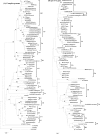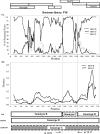Complete genome sequence and phylogenetic relatedness of hepatitis B virus isolates in Papua, Indonesia
- PMID: 19386834
- PMCID: PMC2697109
- DOI: 10.1128/JCM.02328-08
Complete genome sequence and phylogenetic relatedness of hepatitis B virus isolates in Papua, Indonesia
Abstract
Each hepatitis B virus (HBV) genotype and subgenotype is associated with a particular geographic distribution, ethnicity, and anthropological history. Our previous study showed the novel HBV subgenotypes C6 (HBV/C6) and D6 (HBV/D6), based on the S gene sequences of isolates in Papua, Indonesia. The present study investigated the complete genome sequence of 22 strains from Papua and subjected them to molecular evolutionary analysis. A phylogenetic analysis revealed that 9 out of 22 strains were classified as HBV/C6, 3 strains as HBV/D6, and 9 strains as HBV/B3. A particular strain positioned between HBV/B3 and HBV/B5 remained unclassifiable into any known subgenotypes. This strain showed high homology with HBV/C5 from the Philippines in the core region and was thought to have undergone genetic recombination with HBV/C5. Further studies are needed to determine whether this strain belongs to a new subgenotype of HBV/B. Based on the amino acid alignment, HBV/C6 has subgenotype specific variations (G18V and V47M) in the S region. HBV/C6 strains were more closely related in terms of evolutionary distance to strains from the east Asia and Pacific regions than those found in southeast Asia. HBV/D6 strains were most closely related to strains from the Western countries (HBV/D3) rather than those from Asia and Papua New Guinea. In conclusion, we have confirmed by complete sequence analysis that two novel HBV subgenotypes, HBV/C6 and HBV/D6, are prevalent in Papua, Indonesia.
Figures



Comment in
-
Description of a new hepatitis B virus C6 subgenotype found in the Papua province of Indonesia and suggested renaming of a tentative C6 subgenotype found in the Philippines as subgenotype C7.J Clin Microbiol. 2009 Sep;47(9):3068-9. doi: 10.1128/JCM.01079-09. J Clin Microbiol. 2009. PMID: 19721081 Free PMC article. No abstract available.
References
-
- Banerjee, A., F. Kurbanov, D. Sibnarayan, P. K. Chandra, Y. Tanaka, M. Mizokami, and R. Chakravarty. 2006. Phylogenetic relatedness and genetic diversity of hepatitis B virus isolates in Eastern India. J. Med. Virol. 781164-1174. - PubMed
-
- Devesa, M., C. L. Loureiro, Y. Rivas, F. Monsalve, N. Cardona, M. C. Duarte, F. Poblete, M. F. Gutierrez, C. Botto, and F. H. Pujol. 2008. Subgenotype diversity of hepatitis B virus American genotype F in Amerindians from Venezuela and the general population of Colombia. J. Med. Virol. 8020-26. - PubMed
-
- Furusyo, N., N. Kubo, H. Nakashima, K. Kashiwagi, and J. Hayashi. 2004. Relationship of genotype rather than race to hepatitis B virus pathogenicity: a study of Japanese and Solomon Islanders. Am. J. Trop. Med. Hyg. 70571-575. - PubMed
-
- Huy, T. T. T., A. A. Sall, J. M. Reynes, and K. Abe. 2008. Complete genomic sequence and phylogenetic relatedness of hepatitis B virus isolates in Cambodia. Virus Genes 36299-305. - PubMed
Publication types
MeSH terms
Substances
Associated data
- Actions
- Actions
- Actions
- Actions
- Actions
- Actions
- Actions
- Actions
- Actions
- Actions
- Actions
- Actions
- Actions
- Actions
- Actions
- Actions
- Actions
- Actions
- Actions
- Actions
- Actions
- Actions
LinkOut - more resources
Full Text Sources
Medical
Miscellaneous

